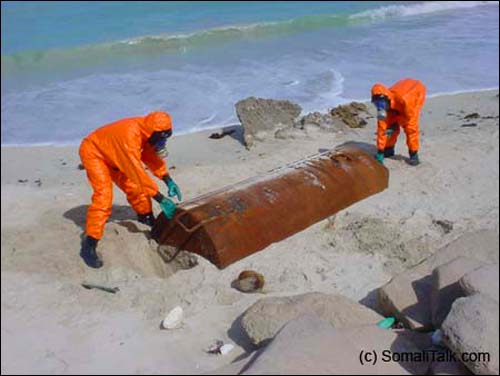Widgetized Section
Go to Admin » Appearance » Widgets » and move Gabfire Widget: Social into that MastheadOverlay zone
More Illegally Dumped Radioactive Waste Found on Somalia’s Coast
Yesterday the BBC reported that radiation levels at the crippled Fukushima reactor site are ten million times normal levels. As the oceans near the damaged nuclear plant are becoming contaminated with increasing amounts of nuclear radiation, concerns are growing about how much radioactive poison the planet’s seas can withstand.
However, although it is not receiving anywhere near as much attention as the unfolding disaster in Japan, the massive amounts of illegally dumped radioactive nuclear waste that are still being thrown into Somalia’s oceans potentially could prove to be an even more deadly catastrophe.

“Safely” Disposed Nuclear Waste?
For decades members of organized crime syndicates and other western companies have been freely dumping tons of radioactive nuclear waste into the unregulated shores off Somalia’s coastline, poisoning the seas and devastating the local population. Somalia has not had a functioning government for many years; the scores of rusty leaking hazardous waste tanks that have been washing up on their shores prove just how many criminals have been exploiting the nation’s inability to protect their own waters.
Project Censored and Boing Boing have been reporting on this horrific situation that is unfolding in the African country:
“…As soon as the government was gone, mysterious European ships started appearing off the coast of Somalia, dumping vast barrels into the ocean. The coastal population began to sicken. At first they suffered strange rashes, nausea and malformed babies. Then, after the 2005 tsunami, hundreds of the dumped and leaking barrels washed up on shore. People began to suffer from radiation sickness, and more than 300 died.
Ahmedou Ould-Abdallah, the UN envoy to Somalia, tells me: ‘Somebody is dumping nuclear material here. There is also lead, and heavy metals such as cadmium and mercury – you name it.’ Much of it can be traced back to European hospitals and factories, who seem to be passing it on to the Italian mafia to ‘dispose’ of cheaply. When I asked Mr Ould-Abdallah what European governments were doing about it, he said with a sigh: ‘Nothing. There has been no clean-up, no compensation, and no prevention.’
At the same time, other European ships have been looting Somalia’s seas of their greatest resource: seafood. We have destroyed our own fish stocks by over-exploitation – and now we have moved on to theirs. More than $300m-worth of tuna, shrimp, and lobster are being stolen every year by illegal trawlers. The local fishermen are now starving.”
Floating in a Sea of Hazardous Nuclear Waste
The Somalia press has also reported details about this ongoing environmental disaster that is being inflicted upon the impoverished nation. Mohammed O. Ali, the Director of Somalia’s Ministry of Aviation and Transport, explains that the once clean blue Somalia seas are now horribly contaminated with a growing toxic-waste nightmare, as more and more western chemical and shipping firms continue to poison their waters. Ali explained that:
“…the toxic dumping, which includes highly radioactive nuclear waste, was destroying the fragile coastal ecology and the livelihoods of hundreds of thousands of Somalis. Some residents in Mogadishu’s coastal areas already reported hundreds of dead fish washing ashore every day.
During the height of the Somali civil war, Swiss and Italian firms Achair Partners and Progresso, signed a secret agreement with the transitional government of warlord Ali Mahdi Mohamed. Taking advantage of the chaos and the fact that Ali Mahdi was desperate for arms and cash to oust rival General Farah Aideed– the European firms began to unload thousands of tonnes of toxic waste arriving in steel drums off the coast of Somalia. Some even made it to the mainland and were buried in 40 inches by 30 inches holes.
The main perpetrators are said to be Italian firms controlled by the mafia, whose job is to dispose Europe’s extremely hazardous waste. Locals also suspect German and Danish shipping companies are in the trade, with some contracted to transport thousands of tonnes of poisonous stockpile including 60, 000 hexachlorobenzene (HCB) barrels from Australia. They say, sometimes instead of taking the hazardous waste to Europe where it can be incinerated, they dump it in the Somali coast to save money and time and also they face strong opposition from Europe’s environmental action groups.
In 2010, Danish, Norwegian and Swedish port staff refused to unload a ship carrying 3000 tonnes of HCB waste from Sydney, Australia. Furthermore they said one gram of HCB was enough to contaminate one billion gallons (over 3 billion litres) of water.”

Figradihiina